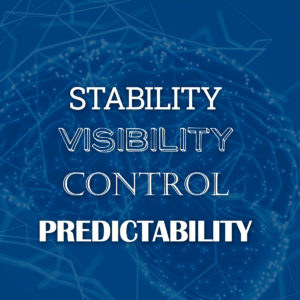
When faced with uncertainty, people make decisions using a toolbox full of shortcuts borrowed from similar situations. When unusual conditions cause sales to freeze up, many marketers open the toolbox and find it empty.
That heightens their perceived uncertainty and risk. Many software vendors – perhaps your company is one of them – are leaning on fear and uncertainty to motivate buyers now. That’s a mistake. Behavioral economics explains why.
Do you understand your buyer’s mindframe right now?
There’s a principle of psychology called prospect theory that I’ve used in marketing for 30-some years. It describes predictable patterns of human judgment under uncertainty and decision-making under risk. Much of buyer behavior during volatility comes down to loss aversion bias, which is the instinctive human response to the risk of losing resources such as money or time.
The more perceived uncertainty, the less people are willing to make changes that might increase the risk of loss — even when doing nothing presents an equal or greater risk of loss.
Buyers today face uncertainty on multiple fronts. Their customers are demanding. Their jobs are no sure thing. And their families live in a violent world. Loss aversion bias is having a field day.

Fear is a poor salesperson
Saying “don’t panic” tells people they should panic. Yet, at the peak of the pandemic, we saw a wave of marketing communications tapping into fear to stimulate buyers to take action.
The primitive brain reacts to threats with fight, flight, or freeze responses. None of those will lead to good customer relationships!
There’s an exception. If your software offers a clear, specific, effective means of reducing the threat, there’s a path from apprehension to acquisition.
Otherwise, starting an email with a banality like “in these uncertain times” is a way to raise barriers, not lower them.
Offer stability, predictability and control
Now you understand why your competitors are using the wrong approach for the loss aversion bias that buyers are experiencing. Organizations have overdosed on fear, uncertainty and doubt. My approach communicates past the bias and helps buyers see beyond the uncertainty.
First, find the aspect of your software that delivers stability, predictability and strength. Develop messaging that focuses on that, then communicate to your market leading with that message.
Identify ways your software puts buyers in control. We helped UCaaS and CCaaS marketers at 8×8 leverage work-from-home case studies as the tip of the marketing spear during the shutdown. ERP, FP&A and other financial software marketers have many potential angles here. Our client PCI Pal linked payment security with business continuity.
Today’s management-to-staff ratio puts an added emphasis on visibility and transparency. Adjust messaging to underscore how your software increases both.

Communicate using social proof
Take down marketing content that doesn’t highlight your strong points of stability, predictability or control in its core message. Replace it with new content ASAP.
In situations of dynamic complexity, people make decisions by looking to what others have done. Customer case studies are an excellent tool for communicating your way past loss aversion.
The more similar the customer is to the buyer, the more effective the case study will be. Large enterprises trust the experiences of other large enterprises, companies relate to the decisions of others with similar social values, and so on.
Customer case studies leverage another powerful psychological device. Storytelling reaches past the executive brain and talks directly to the primal brain. Buyers reading well-written stories about other companies will internally react as though they had that good experience themselves.
Make the next step easy
With risk already high, your prospects need a low-risk, easy step toward buying. Consider whether gated content needs a detailed lead-gathering form. Can you get by with minimal information to start with? Is lead gathering the best first step at all?
For example, I provide information like this without asking for contact info, and let marketers decide when is the right time to reach out. When that time comes for you, start here.